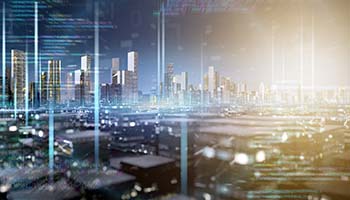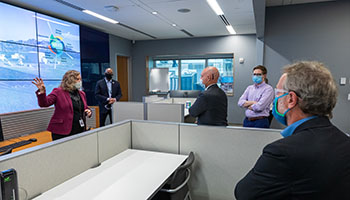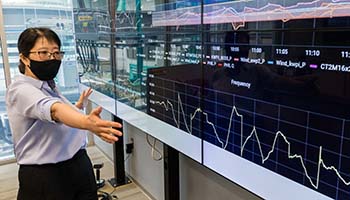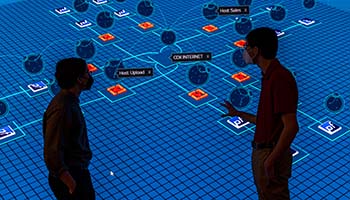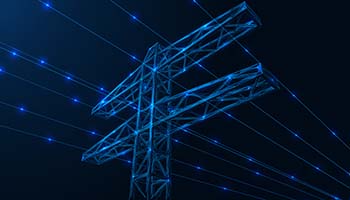ARIES is the nation's most advanced research platform for clean electric grid integration research and validation. It is designed to support the nation’s transition to a decarbonized energy system.
ARIES addresses these key challenges to the energy grid:
- Variability in the physical size of new energy technologies added to energy systems
- Secure control of tens of millions of interconnected devices
- Integration of diverse technologies that have not previously worked together.
The world is embarking on an unprecedented energy transition, and every day brings a reminder that we must act fast. Each blackout from a storm or sobering statistic about the global impact of our energy use reminds us that change is here. We need clean and resilient energy systems right now, and that will require an accelerated path from breakthrough to real-world deployment. The ARIES research platform at NREL is the United States' most powerful research capability to support the transition to a clean energy future. And in its first full year of operation, it is already delivering results.
But results from early ARIES projects are only the tip of the iceberg. Although ARIES has achieved exciting demonstrations during the past year, we see greater opportunities as we commit completely to the clean energy transition. As more groups partner with us, and as we further develop ARIES capabilities, we expect that this unique research and development platform will provide the guiding light for clean, efficient, and resilient energy everywhere.
Sincerely,
Jennifer Kurtz, ARIES Director
Johney Green, Associate Laboratory Director for Mechanical and Thermal Engineering
Sciences
Juan Torres, Associate Laboratory Director for Energy Systems Integration
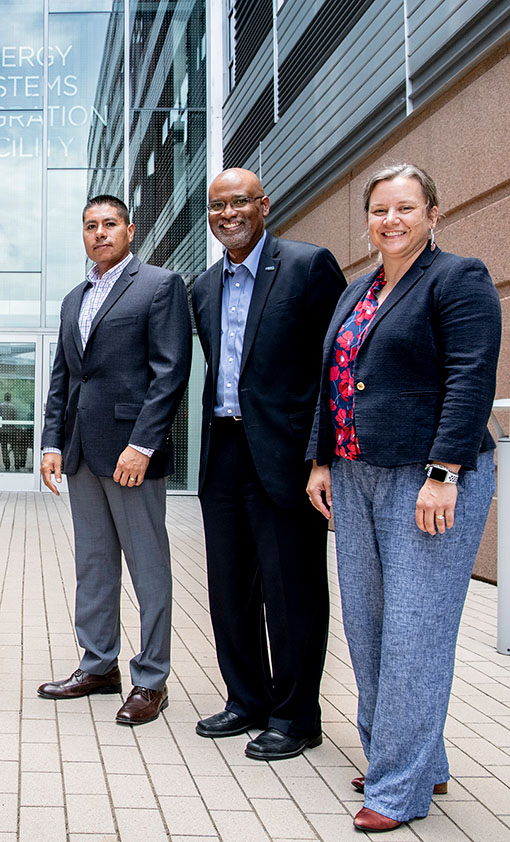
Our Goals
ARIES supports the clean energy goals of the U.S. Department of Energy (DOE) to put the United States on a path to carbon-free electricity by 2035 and economywide, net-zero greenhouse gas emissions by 2050. ARIES research areas focus on decarbonizing the economy while supporting environmental justice, workforce development, and state and local partnerships.
Office of Energy Efficiency and Renewable Energy Programmatic Priorities
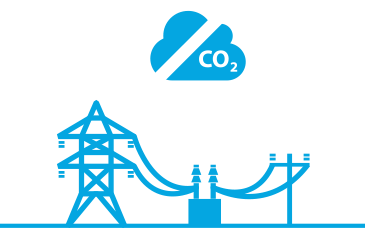
1. Achieving a carbon-free electricity sector by 2035
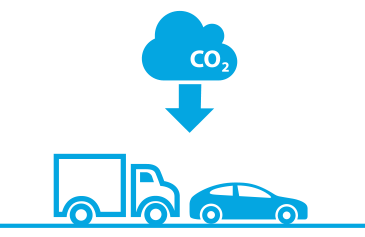
2. Decarbonizing the transportation sector
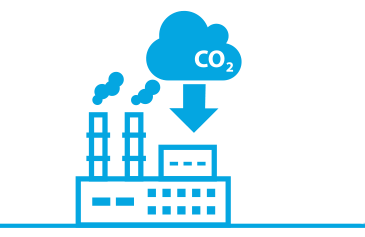
3. Decarbonizing the industrial sector
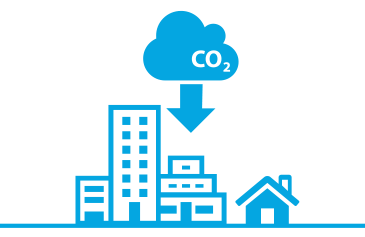
4. Reducing the carbon footprint of buildings across the nation
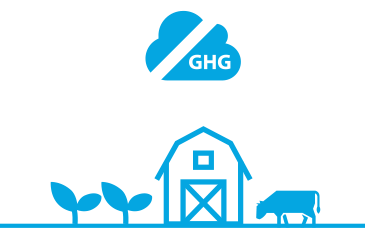
5. Enabling a net zero agricultural sector, proving savings to farmers and rural communities across the country
Research Highlights
Digital Twin Capability Provides Customized Approach to Port Modernization
Dallas/Fort Worth International Airport (DFW) wants to become one of the world's cleanest and most energy-efficient hubs. It engaged NREL and ARIES to visualize that energy transition. With a digital twin of DFW operations, NREL researchers are helping the airport consider the effects of investments and decisions on passenger experience, energy use, and airport revenue before committing to a particular approach. This work leverages a larger effort, called Athena, to create an interactive analysis environment powered by NREL's supercomputer and customized with data from actual airport activities. For the first time, data science and modeling and analysis are providing the world's busiest hubs clear insights to help guide 20-plus-year investments in clean energy and efficiency.
Department of Defense Develops Renewable Microgrids Through ARIES Emulation
The ARIES platform hosts a technology acceleration program that pairs startups with energy mainstays to advance storage and microgrid solutions from concept to application. ARIES' unique plug-and-play environment allows industry to quickly ramp up its real-world experience and vet its technologies against the challenges of true resilience events. Funded by the U.S. Department of Defense, the Environmental Security Technology Certification Program offers technical assistance to participants in the form of rigorous sink-or-swim validation rounds. Results of the program are released to the public so entities with critical loads can incorporate the latest solutions for energy resilience. With ARIES, critically resilient technologies can now experience the trials of a true emergency from the safety of the lab
Hydrogen Hardware Smooths Demand From Electric Vehicle Charging
NREL researchers are using a 750-kW electrolyzer integrated with ARIES hardware to show that grid-scale electrolyzers can reduce the uncertainty of electric vehicle charging demand. Electrolyzers are less sensitive to changes in power supply than other loads, making them a potentially useful technology to balance more jumpy loads, such as electric vehicle charging stations. In experiments that varied the number and power demand of electric vehicle chargers, researchers showed that the commercial electrolyzer could follow the erratic demand of charging, effectively smoothing overall demand while generating clean hydrogen for other applications. Findings from the project are important for the emerging topic of hydrogen-grid integration.
ARIES Supports First Example of Grid-Forming Wind Turbines
NREL is making the transition to renewably sourced grid stability seamless by designing new controls for renewable technologies. In this breakthrough, NREL and GE demonstrated grid-forming controls—the ability to supply fundamental stability and stand-alone power to the grid—for Type 3 wind turbines. As renewables become an increasingly larger share of the power supply, they are also taking a larger share of responsibility as stewards of grid stability, a service traditionally provided by fossil-fueled generators. Grid-forming controls could allow wind turbines to fulfill a wider role on the electric grid by providing the ability to black-start following outages, setting the underlying grid frequency and voltage, and providing critical stabilizing services—all of which open new value streams for wind and hybrid power plants.
ARIES Sparks Forward-Thinking Alternative to Power Distribution With Compact Medium-Voltage Converters
An ARIES initiative is spearheading a technology that could fundamentally redesign the electric grid. NREL is working with partners to develop medium-voltage, back-to-back converters. The project is called Grid Application Development, Testbed, and Analysis for Medium-Voltage Silicon Carbide (GADTAMS), and it targets a game-changing solution for renewable integration, grid resilience, and adaptability. GADTAMS proposes a hardware solution to reliably integrate more distributed energy resources: compact power converters separating areas of the medium-voltage grid so independent sections can become microgrids as needed. But instead of the heavy, impractical converters on offer today, GADTAMS converters will be one-fifth the size and one-tenth the weight—and they will allow advanced controllability.
ARIES Validates Hardware for National Initiative on Hybrid Renewable Power Plants
NREL is leading a coalition of national laboratories and industry partners to create the next generation of power plants: hybrid plants that combine renewable and conventional resources. "Clusters of Flexible PV-Wind-Storage-Hybrid Generation," or FlexPower, is using ARIES infrastructure to validate hybrid controls on the full range of energy resources, including hydroelectric and thermal generation, and on novel technologies spanning energy storage and power-to-gas. Results from the project could allow industry to increase the value of renewable investments by bestowing modern resources with the flexibility to participate in new ways on the electric grid. Rather than being simple sources of power generation, renewables and hybrid power plants can now offer more complex grid support, such as frequency stability and stand-alone resilience.
ARIES Is Helping Maui Prepare for 100% Renewable Energy
NREL is using ARIES assets to design a replica Maui power system and develop operational tools to understand the effects of transitioning to high- and all-renewables operation. One such tool is MIDAS, the Multi-Timescale Integrated Dynamic and Scheduling framework, which allows the local utility to manage dispatch on energy systems with higher shares of renewables. The MIDAS framework will bolster inverter-based resources (such as wind, solar, and storage) in providing frequency and voltage stability for low-inertia electric grids—services that are becoming more important as renewables displace traditional sources of grid stability. As Maui's objective to achieve 100% renewables approaches reality, MIDAS and ARIES demonstrations will provide a useful tool kit to de-risk planning and operations for other utilities shifting to renewable resources.
Scalable Method for 100% Renewables Systems Emerges From Surprise NREL Outage
Not long after upgrading ARIES infrastructure, NREL experienced a blackout on its Flatirons Campus. NREL's research showed that renewable resources can provide fundamental power system resilience, and the blackout offered an opportunity to prove it. Within 1 week, NREL researchers customized a quick-and-ready microgrid configuration using an on-site wind turbine, a utility-scale solar PV array, and a large lithium-ion battery. In the interest of time, they installed simple, reproducible controls on each renewable device. With the distributed controls, NREL's renewable microgrid managed to black-start the campus and maintain stable power until the failed equipment could be replaced. Though unplanned, the demonstration proved that an all-renewables system could provide fundamental resilience and stability for future grids.
Clean Energy Cybersecurity Accelerator Speeds Cyber Innovation
New grid devices are being connected rapidly, and although this benefits consumers, it can also expose risks that are not yet well understood. Using ARIES, the Clean Energy Cybersecurity Accelerator is identifying security gaps in the electric grid and expediting solutions to market. In October 2021, NREL announced the launch of the Clean Energy Cybersecurity Accelerator, a technology partnership of federal experts, industry partners, and innovators to accelerate the deployment of cybersecurity solutions for the nation's evolving grid. Using NREL's cyber range in the ARIES platform, the accelerator provides an environment in which innovative cybersecurity technologies can be evaluated against threat scenarios without putting customers or utility networks at risk.
Modeling Subsea Microgrid Links for Alaskan Archipelago
By validating technologies on ARIES assets, remote Alaskan communities can make bold and informed decisions that enhance energy resilience, reliability, and efficiency for important commercial sites. Southeast Alaska is dotted with coastal communities that are electrically isolated and rely on local generation such as diesel or run-of-river hydropower. marine hydrOkinetic-based reliable and Resilient eleCtrification in Alaska (ORCA) modeled options to link cities with undersea cables and provide a resilience-enhanced renewable energy portfolio for their harsh weather and dynamic grid conditions. The ORCA project used ARIES to build a model of the Alaskan archipelago that features medium-voltage DC connections to generators, creating a networked microgrid system for added resilience and reliability at a reduced cost.
Scalable Stability With Grid-Forming Controls
Upcoming power electronic devices could unlock new approaches to transmission-scale grid control. ARIES will be a proving ground for demonstrating how creative configurations of these modern resources can have a more supportive role on the electric grid. NREL has developed SuperFACTS (Super-Flexible and Robust AC Transmission System), a scalable concept that combines grid-forming battery energy storage and synchronous condenser capabilities in a single system that can be controlled to provide fully dispatchable and flexible operation. The SuperFACTS concept is an innovative, scalable, and highly reliable solution that can be sized and deployed in numbers to function in a variety of system designs and sizes, with the potential to become a key reliability enabler for 100% carbon-free smart grids.
Lab Capabilities and Buildouts
We can link models and simulations across the national laboratory complex, but what if we could also connect them with equipment, devices, and scientists? In a future like this, researchers could run experiments that leverage thousands of devices to model the millions of devices in our increasingly complex energy system.
In June, ARIES took a step toward that future by completing a high-speed network connection between NREL's Flatirons and South Table Mountain campuses. The network went from a single 10-GB connection to dual 100-GB connections—a 10-fold improvement.
ARIES researchers also worked with DOE's Energy Sciences Network to establish an On-Demand Secure Circuits and Advance Reservation System circuit between NREL and Pacific Northwest National Laboratory. Established in July, this fixed-route, low-latency connection allows researchers to leverage the resources of two national labs to conduct real-time simulations.
Together, these are the first steps to developing a federated lab complex that can conduct research that no single lab or entity could achieve on its own.
Platform To Explore Integration and Impact of Power Electronics
The Power Electronic Grid Interface is a plug-and-play environment that provides medium-voltage, megawatt-scale testing for energy system integration solutions.
Higher-Power Grid Interface for City-Scale Power Flow Scenarios
ARIES is leveling up its capacity to customize power flow scenarios. A new 20-MVA controllable grid interface will soon connect incoming power to the NREL campus.
Grid Integration Research Through the Control Center Facility
The Control Center Facility will provide centralized control of energy integration research and development activities at the Flatirons Campus.
Real-Time Simulator Ties Virtual Environments to Physical Validation
The digital real-time simulator bridges cyber and physical capabilities by sending low-latency information between virtual environments and hardware infrastructure.
Cyber Range and Communications Assets To Manage Virtual Connectivity
The ARIES cyber environment allows researchers to visualize and interact with data flow among devices in an immersive cyber range.
Power Line Upgrade To Study Transmission-Distribution Dynamics
A new 34.5-kV transmission line links ARIES assets to the local utility. Substation infrastructure allows research at the boundary of transmission and distribution systems.
Engagement and Outreach
ARIES is engaging with communities, industry leaders, and academic partners to ensure our research and capabilities meet the real-world needs of the energy system. Fiscal Year 2021 engagement and outreach activities included presenting at more than 35 speaking engagements, convening two advisory groups, soliciting a user call and request for information, and engaging communities to support their energy transition strategies.

Sept. 30, 2020:
ARIES User Call – 191 user requests (128 continuing projects and 63 new projects) for Fiscal Year 2021 resources
Oct. 13, 2020:
Power Electronics Grid Interface Workshop – 140 attendees
Feb. 24, 2021:
Energy Storage Workshop – 180 attendees from industry, NREL, DOE, and other national labs
July 15, 2021:
U.S. Secretary of Energy Jennifer Granholm virtually tours NREL and learns about ARIES
July 21, 2021:
Alaska Governor Mike Dunleavy visits NREL and learns about ARIES
Aug. 2021:
Advanced Distribution Management System Test Bed request for information closes with 13 submissions, leading team to develop a user call later in the year
Aug. 23, 2021:
Alaska Senator Lisa Murkowski visits NREL's South Table Mountain campus and learns about ARIES
Aug. 25, 2021:
Inaugural Executive Advisory Board meeting
Sept. 8–9, 2021:
Deputy Secretary of Energy David Turk visits NREL's South Table Mountain Campus and Flatirons Campus and learns about ARIES
Sept. 14, 2021:
President Biden visits NREL's Flatirons Campus to announce his Build Back Better Plan and is briefed on ARIES capabilities
Sept. 15, 2021:
DOE Acting Assistant Secretary and Principal Deputy Secretary for EERE Kelly Speakes-Backman visits NREL
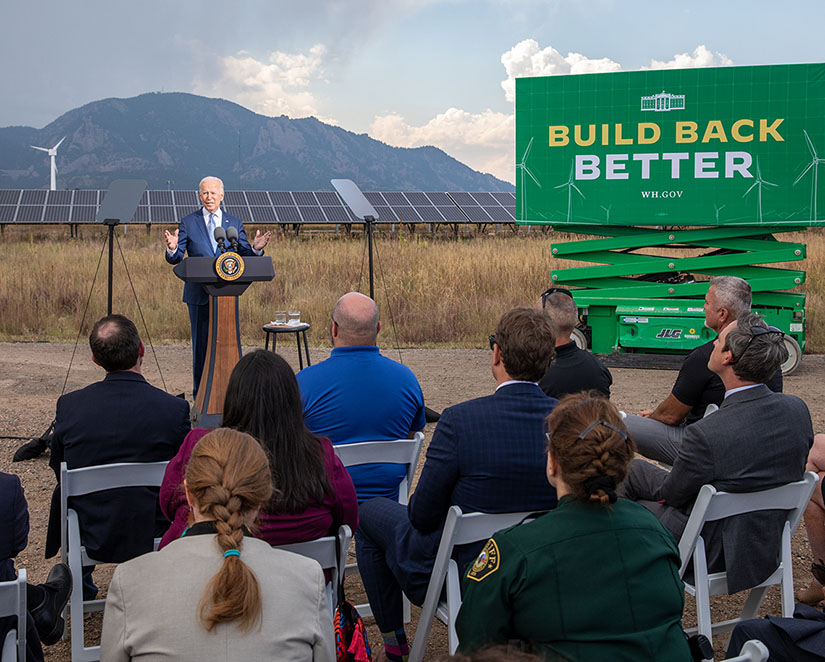
Communities to Clean Energy
More than 170 U.S. cities and communities have committed to meeting their electricity needs with 100% renewable energy. The paths to reach those goals are not always clear and vary based on different priorities and circumstances within each community. To help them reach their goals, NREL is engaging cities, communities, utilities, and other stakeholders through the C2C. As C2C communities work toward their clean energy plans, many will use ARIES to evaluate the technical feasibility of solutions before full implementation, thereby de-risking large-scale deployments.
Looking Ahead
In the coming years, ARIES will develop capabilities that will advance leading-edge energy integration research. Using ongoing capital investments driven by DOE priorities, industry collaboration, and the ARIES Research Plan, ARIES will grow to meet the energy research demands of the future.
Efforts for Fiscal Year 2022 and beyond include:
Partnership To Develop Hydrogen at Scale
DOE announced nearly $8 million for nine cooperative projects that will complement existing H2@Scale efforts and support DOE's Hydrogen Shot goal of reducing the cost of clean hydrogen by 80% within the decade. Projects will leverage the ARIES platform to enable the integration of hydrogen technologies, including energy storage, in future energy systems, with a specific focus on safety and risk mitigation.
Advanced Distribution Management System User Call
NREL's Advanced Distribution Management System research helps utilities meet customer expectations of reliability, power quality, renewable energy use, data security, and resilience to natural disasters and other threats. NREL is accepting proposals from external research partners for projects that require the Advanced Distribution Management System Test Bed.
Real-Time Distributed Simulation Demonstration Using ESnet
By demonstrating real-time energy simulations between two national labs thousands of miles apart, NREL and Pacific Northwest National Laboratory proved the concept of a "SuperLab." Next, ARIES will connect more national labs until it achieves the seven-lab "SuperLab 2.0." In doing so, ARIES will blur the line between NREL and the outside—connecting physical and virtual research tools across campuses.
Advisory Committees
ARIES Steering Committee
The ARIES Steering Committee comprises EERE and NREL executive leadership. This committee meets quarterly and has oversight of and responsibility for ARIES research and development management, research impact, and financial and business practices.
ARIES Executive Advisory Board
The ARIES Executive Advisory Board provides an external perspective to NREL, DOE, and EERE on the research direction, development, and deployment of the ARIES research platform.
ARIES External Advisory Board
Chair: Gary Smyth
Executive Director, Global R&D Laboratories
General Motors (retired)
Jeffrey Baumgartner
Director, Threat Intelligence and National Security Engagements
Berkshire Hathaway Energy
Colton Ching
Senior Vice President, Planning and Technology
Hawaiian Electric Co.
Lauren Faber O'Connor
Chief Sustainability Officer
Office of Los Angeles Mayor Eric Garcetti
Paula R. Glover
President
Alliance to Save Energy
Christopher Herbst
Vice President, Strategic Partnerships and Innovation
Eaton
Robert Horton
Vice President Environmental Affairs and Sustainability
DFW Airport
Alice K. Jackson
President
Xcel Energy – Colorado
Danielle W. Merfeld
Vice President and Chief Technology Officer
GE Renewable Energy
Teresa R. Pohlman
Director, Sustainability and Environmental Programs
U.S. Department of Homeland Security
Ronald M. Sega
Chief Technology Officer
U.S. Army Futures Command
Jim Spiers
Senior Vice President, Business and Technology Strategies
National Rural Electric Cooperative Association
Timothy D. Unruh
Executive Director
National Association of Energy Service Companies
Download
Read more about ARIES Fiscal Year 2021 accomplishments by downloading the full report.
Learn more about the NREL facilities that make ARIES research possible in these companion annual reports:
Test
Share
Last Updated Feb. 12, 2025


